Electric scooters are gaining popularity as a convenient and urban transportation option. How much electricity do they consume? What are the charging costs? This article will address these inquiries using US data.
We will also compare electric scooters to cars, bikes, and public transit, analyzing their environmental impact. Gain a comprehensive understanding of electric scooter power consumption and optimize your e-scooter experience through this article’s insights.
Table of Contents
What Factors Affect the Electricity Consumption of an Electric Scooter?
The electricity usage of an electric scooter depends on various factors, including:
- The battery’s capacity and voltage, determine its ability to store and supply electricity.
- The efficiency of charging, which is the ratio of input energy to the battery compared to output energy. Charging efficiency varies based on charger type, battery condition, and ambient temperature.
- The speed and distance traveled on the electric scooter. Higher speeds and longer distances result in increased electricity consumption.
- The terrain and road conditions encountered. Riding uphill, on rough or uneven surfaces, or against strong winds leads to higher electricity usage.
- The rider’s weight and behavior. Heavier riders and those who speed up or brake will need more electricity.
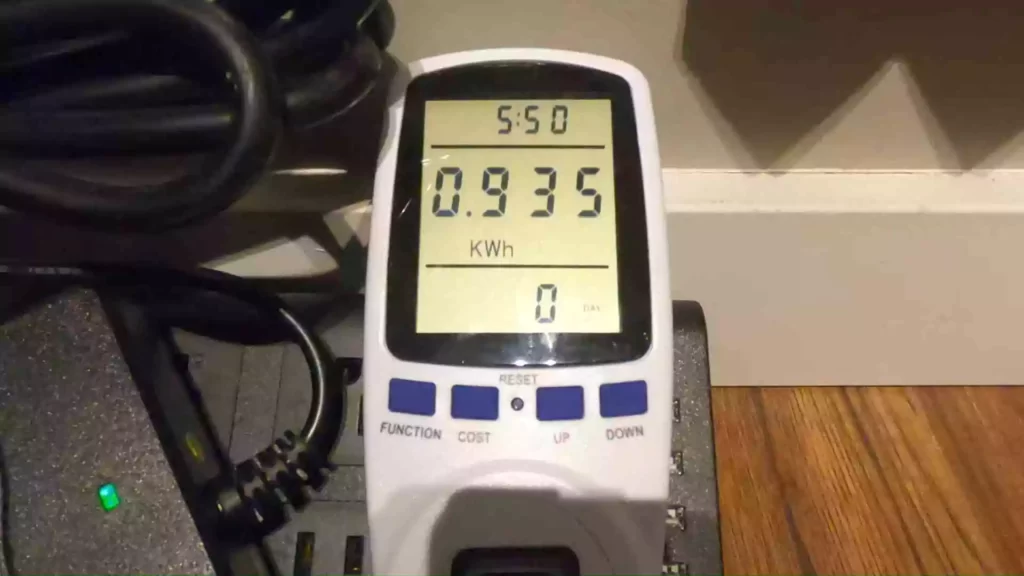
How to Calculate the Electricity Consumption of an Electric Scooter?
To determine the electric consumption of an electric scooter, you must be aware of two factors: the battery’s watt-hours (Wh) and the electric scooter’s watt-hours per mile (Wh/mi).
The battery’s watt-hours represent the energy capacity and output of the battery, obtainable from the battery label or user manual. If, for instance, your electric scooter features a 36V 10Ah battery, the watt-hours would amount to 36 x 10 = 360 Wh.
The watt-hours per mile signify the energy consumed by the electric scooter for each mile of travel. While this value may vary due to different elements, you can use an average figure based on your typical riding conditions. an urban commuting average is 10 Wh/mi.
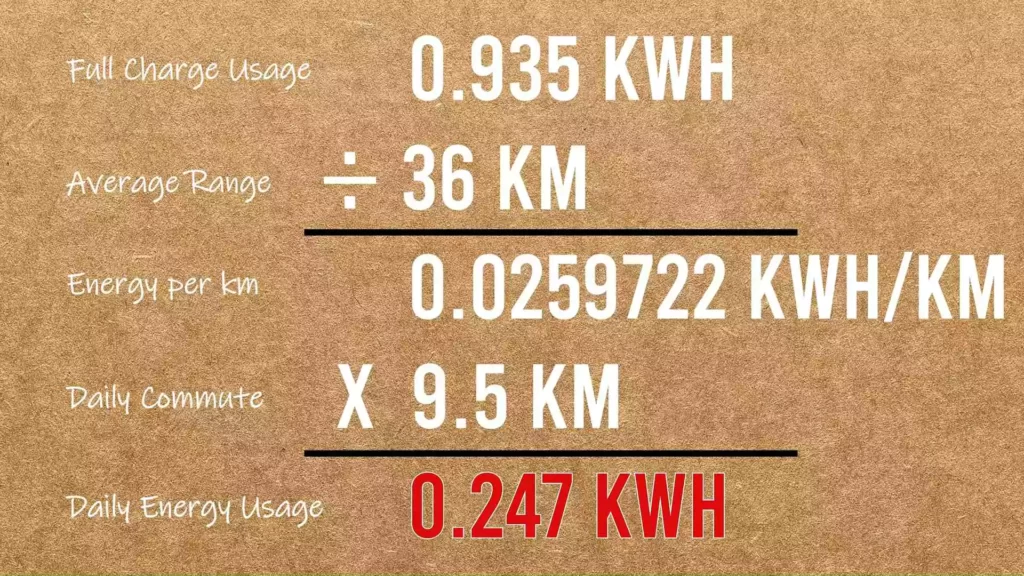
To determine the electric consumption per mile, divide the watt-hours of the battery by the watt-hours per mile. For example, if your scooter has a 360 Wh battery and consumes 10 Wh/mi, the distance covered would be 360 / 10 = 36 miles.
To calculate the electric consumption per hour, multiply the watt-hours per mile by your average riding speed. For instance, if your scooter consumes 10 Wh/mi and you ride at 15 mph, it would amount to 10 x 15 = 150 Wh/h.
How Much Does It Cost to Charge an Electric Scooter?
To determine the cost of charging an electric scooter, you need two pieces of information: the kilowatt-hours (kWh) of electricity consumed during charging and the cost per kWh.
To obtain the kWh used for charging, divide the watt-hours (Wh) of the battery by 1000. For instance, if your electric scooter has a 360 Wh battery, it would require 360 / 1000 = 0.36 kWh for a full charge.
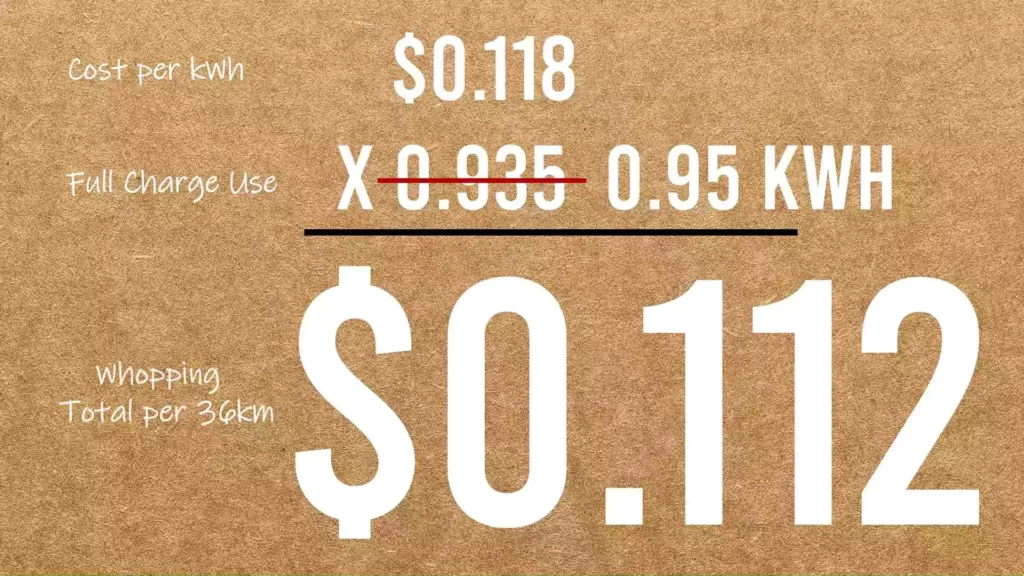
The cost per kWh varies based on your location, utility provider, and plan. As of October 2021, the average residential price for electricity in the United States was $0.1368 per kWh, according to the U.S. Energy Information Administration.
To calculate the total cost of fully charging an electric scooter, multiply the kWh of electricity by the price per kWh. For example, if your scooter consumes 0.36 kWh and you pay $0.1368 per kWh, the total cost would be 0.36 x 0.1368 = $0.0492.
To determine the cost per mile of charging, divide the total charging cost by the scooter’s range. For instance, if it costs $0.0492 to fully charge and your scooter has a range of 36 miles, then the cost per mile would be 0.0492 / 36 = $0.0014.
How Do Electric Scooters Compare with Other Modes of Transportation?
E-scooters are not only fun and convenient, but they’re also eco-conscious when compared to other transportation options.
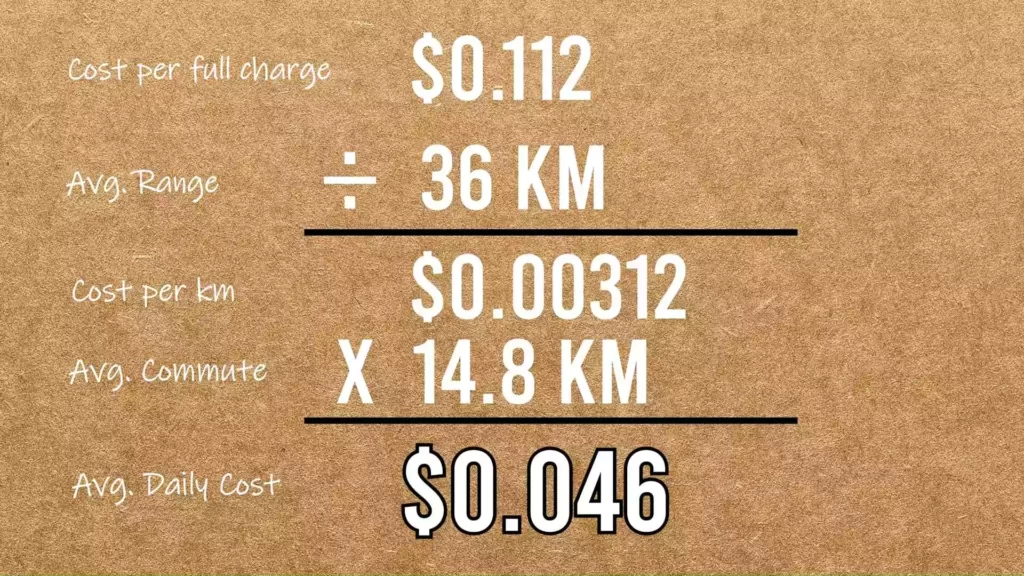
- Cars use around 300 Wh/mi and emit about 0.4 kg of CO2 per mile. Bikes consume approximately 30 Wh/mi and emit roughly 0.04 kg of CO2 per mile. So e-scooters only need about 10 Wh/mi and emit a mere 0.01 kg of CO2 per mile.
- When it comes to costs, operating a car can set you back around $0.12 per mile, assuming a gas price of $3.6 per gallon and a fuel efficiency of 30 mpg. Bikes cost roughly $0.01 per mile to maintain, with an annual maintenance expense of $100 and a mileage of 10,000 miles per year. As for e-scooters, they only cost about $0.0014 per mile to run, considering an electricity price of $0.1368 per kWh and an 80% charging efficiency.
- For travel time, cars take about 10 minutes to cover two miles in the city, assuming an average speed of 12 mph and no traffic. Bikes take approximately 12 minutes to travel the same distance, with an average speed of 10 mph and no traffic. But, e-scooters can cover two miles in 8 minutes, thanks to their average speed of 15 mph and no traffic.
To sum it up, e-scooters offer a more efficient, cost-effective, and time-saving mode of transportation, especially for short-distance urban commutes. Hop on an e-scooter and enjoy the benefits of a friendly, ride!
What Are the Benefits and Drawbacks of Electric Scooters?
Electric scooters offer numerous advantages, including:
- User-friendliness, ease of operation, and low maintenance. Simply charge them regularly and adhere to safety guidelines.
- Portability and foldability. You can conveniently transport them on public transit, in your car trunk, or to your office.
- Enjoyment and excitement. Ride at your own pace, discover new places, and feel the refreshing breeze on your face.
- Health and well-being benefits. Burn calories, enhance balance and coordination, and alleviate stress.
- Positive impact on the environment and society. Reduce your carbon footprint, noise pollution, and traffic congestion.

Electric scooters have certain drawbacks, such as:
- Limited suitability in adverse weather conditions and challenging terrains. Rain, snow, ice, mud, gravel, or potholes can affect your safety and riding experience.
- Variable legality and regulations. Familiarize yourself with local laws and regulations before riding an electric scooter in a new area.
- Potential safety and comfort concerns. Accident, injury, theft, or vandalism risks can result in damage to yourself or your electric scooter.
- Considerable cost and durability factors. Investing in a high-quality electric scooter is necessary for prolonged performance and durability.
How to Choose the Best Electric Scooter for Your Needs?
If you want to buy an electric scooter, there are various aspects to consider:
- Your budget and preferences are significant. Determine your spending limit and desired features in an electric scooter.
- Consider your riding purpose and frequency. Decide your motivation for riding and how you plan to use it.
- Assess your riding style and skill level. Determine your desired speed and distance, as well as your confidence and experience as a rider.
- Check your riding environment and conditions. Consider where you intend to ride and the weather and terrain you may encounter.
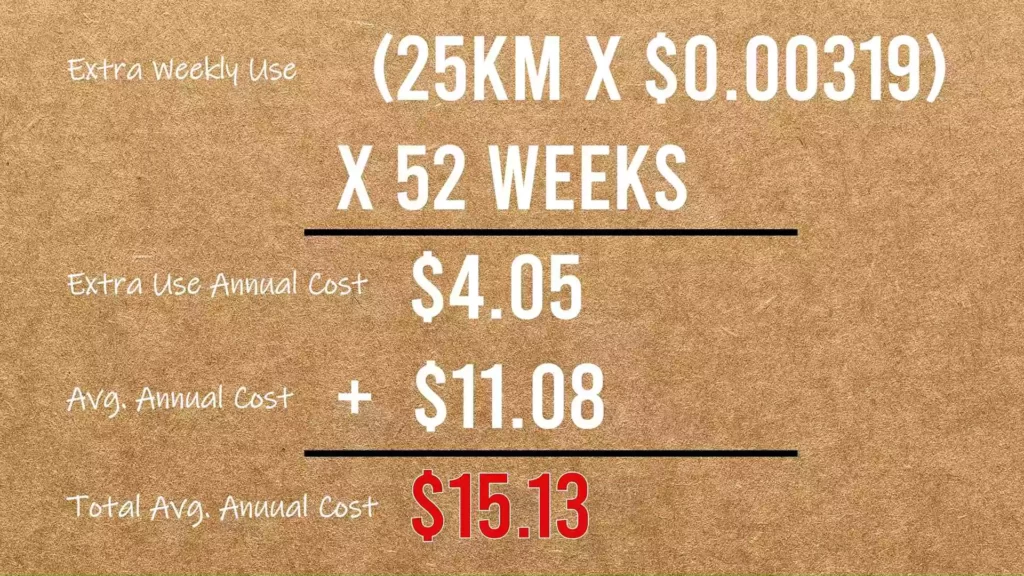
By considering these factors, you can compare different electric scooter models available in the market and select the one that best fits your needs.
Conclusion
Electric scooters provide a handy and effective way to get around cities. Their energy efficiency distinguishes them from conventional transportation options, bringing economic and eco-friendly advantages. Nonetheless, potential buyers need to be aware of some drawbacks in advance.
We aim to improve your understanding of electric scooter power consumption and offer tips for optimizing its usage. If you have any questions or suggestions, feel free to leave a comment. Enjoy your rides!
The data source for all images and details: YouTube & EIA
FAQ section
How many units of electricity does it take to charge an electric scooter?
It depends on how much juice your scooter’s battery can hold, but let’s say you’ve got a standard electric scooter rocking a 36-volt battery with a 6000 mAh capacity. To charge it up completely, you’re looking at slurping up roughly 0.2 kWh of power. In the good ol’ US of A, that’s about the same as using 1 unit of electricity.
How much does it cost to charge an electric scooter in the United States?
The cost of charging an electric scooter in the United States varies depending on the electricity rate. In general, it costs between $0.03 and $0.05 per kWh to charge an electric scooter. This means that it costs between $0.06 and $0.10 to charge a typical electric scooter fully.
How efficient are electric scooters in terms of electricity use?
E-scooters are highly efficient in terms of electricity usage. They consume less energy per kilometer than automobiles, making them ideal for short trips. An average e-scooter can cover 15 to 25 kilometers on one charge.
How far can an electric scooter travel on a single charge?
The range of an electric scooter on one charge depends on various factors like battery capacity, rider weight, and terrain. On average, electric scooters can travel 15 to 25 kilometers per charge.
What factors affect the amount of electricity used by an electric scooter?
The electricity consumed by an electric scooter is influenced by multiple factors like rider weight, terrain, and scooter speed. Riding slower and on a flat surface reduces electricity usage. Battery capacity also impacts consumption. A scooter with a bigger battery can travel longer on one charge.
How can I save electricity when charging my electric scooter?
To save electricity while charging an electric scooter, you have several options available. One approach involves employing a smart charger capable of optimizing the charging procedure. Another method entails charging the scooter during off-peak hours when electricity costs are lower. Additionally, you can conserve electricity by riding at a slower pace and avoiding uphill routes.
Join the electric revolution with Tensela - your gateway to a greener future on two wheels!
